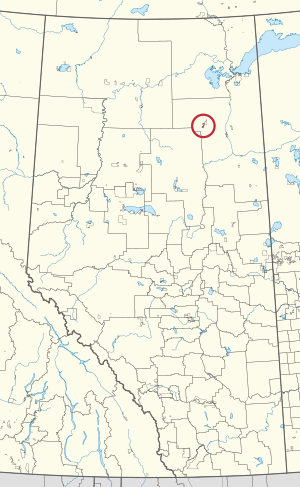Namur Lake 174B facts for kids
Quick facts for kids
Namur Lake 174B
|
|
|---|---|
| Namur Lake Indian Reserve No. 174B | |

Location in Alberta
|
|
| First Nation | Fort McKay |
| Treaty | 8 |
| Country | Canada |
| Province | Alberta |
| Specialized municipality | Wood Buffalo |
| Area | |
| • Total | 3,122.2 ha (7,715.1 acre) |
Namur Lake 174B is a special area of land in Alberta, Canada. It's known as an Indian reserve, which is land set aside for the use of a First Nation community. This particular reserve belongs to the Fort McKay First Nation.
Contents
What is Namur Lake 174B?
Namur Lake 174B is an official Indian reserve located in the province of Alberta, Canada. It is a designated area of land for the Fort McKay First Nation, an Indigenous group in Canada. This reserve is part of the Regional Municipality of Wood Buffalo.
Where is Namur Lake 174B Located?
This reserve is found in northern Alberta. It is about 105 kilometres (which is about 65 miles) northwest of a larger town called Fort McMurray. This area is known for its vast forests and natural landscapes.
Who is the Fort McKay First Nation?
The Fort McKay First Nation is an Indigenous community in Canada. They are part of the Dene and Cree peoples. Their traditional lands are in the Athabasca oil sands region of northeastern Alberta. The Namur Lake 174B reserve is one of the lands they call home.
Understanding Indian Reserves in Canada
In Canada, an Indian reserve is a piece of land that the government has set aside for the use of First Nations people. These lands are managed by the First Nations themselves, often with support from the Canadian government. Reserves are important places for First Nations communities to live, practice their culture, and govern themselves.
The Importance of Treaty 8
Namur Lake 174B is part of the lands covered by Treaty 8. A treaty is a formal agreement between different groups of people. Treaty 8 was signed in 1899 between the Canadian government and several First Nations, including the ancestors of the Fort McKay First Nation. These treaties set out promises and agreements about land use, hunting, fishing, and other rights. They are still very important today for understanding the relationship between First Nations and Canada.

